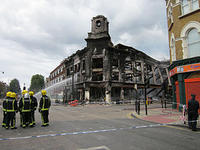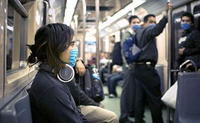-
Training the nuclear forensics experts of the future
Ten percent of the U.S. experts in nuclear and radiochemistry are at or nearing retirement age, according to a recent report from the National Academies of Science; meanwhile, not enough students are being trained to take their places; undergraduate summer programs in nuclear forensics and nuclear chemistry aim to replenish the ranks
-
-
Novel network model to help in cyberwarfare, conservation, and disease prevention
Computer networks are the battlefields in cyberwarfare, as exemplified by the U.S. recent use of computer viruses to attack Iran’s nuclear program; researchers develop a computer model which could help military strategists devise the most damaging cyber attacks as well as guard America’s critical infrastructure
-
-
Explaining 2011 extreme weather events

2011 will be remembered as a year of extreme weather events, both in the United States and around the world; NOAA says that every weather event that happens now takes place in the context of a changing global environment; a comprehensive annual report – State of the Climate in 2011 — provides scientists and citizens with an analysis of what has happened so organizations and individuals can prepare for what is to come
-
-
Changing climate to lead to fewer, but more violent, thunderstorms

Researcher predict that for every one degree Celsius of warming, there will be approximately a 10 percent increase in lightning activity; this could have negative consequences in the form of flash floods, wild fires, or damage to power lines and other infrastructure
-
-
Natural gas is good for the economy, environment
No matter how we drill it, using natural gas as an energy source is a smart move in the battle against global climate change and a good transition step on the road toward low-carbon energy from wind, solar, and nuclear power
-
-
Study: Islamist extremists emphasize self-defense, not world domination
A common belief in the West is that al Qaeda wishes to impose Islam everywhere; this might be a pipe dream for the group, but a new study of their use of religious texts suggests that Islamists’ goals are much more modest
-
-
A 10-year plan for Europe’s grid
A new study shows that 104 billion euro over ten years need to be invested in the refurbishment or construction of roughly 52,000 km of extra high voltage power lines and cables across Europe in order to add 3 percent generation capacity and the reliable integration of 125 GW of renewable energy sources
-
-
A record: half of U.S. land area is in various stages of drought

Analysis of the latest drought monitor data revealed that 46.84 percent of the U.S. land area is in various stages of drought, up from 42.8 percent a week ago; previous records were 45.87 percent in drought on 26 August 2003, and 45.64 percent on 10 September 2002; looking only at the forty-eight contiguous states, 55.96 percent of the country’s land area is in moderate drought or worse — also the highest percentage on record
-
-
Students and scientists gather in Singapore to discuss water problem
International university students and water experts have converged at Singapore’s Nanyang Technological University (NTU) to foster an intellectual and research community on a scarce natural resource — water
-
-
Just-the-facts climate change Web site wins World Bank award
The World Bank award a prize to a Web site built to be the antidote to the many myths circulating online about climate change, myths which cause misplaced apathy or alarm; the site also reveals how responding to climate change presents a world of opportunities for individuals and entrepreneurs
-
-
UAV Code of Conduct for unmanned aircraft systems operations released
The Association for Unmanned Vehicle Systems International (AUVSI) has published the Unmanned Aircraft System Operations Industry Code of Conduct, a set of guidelines to provide AUVSI members — and those who design, test, and operate unmanned aerial systems (UAS) for public and civil use — with recommendations for their safe, non-intrusive operation
-
-
The U.K. August 2011 riots could have been predicted

Researchers studying urban violence have developed a new method which can help city authorities to assess the conditions where conflict could potentially tip into violence; Participatory Violence Appraisal (PVA), used in Kenya and Chile, could have helped to anticipate the tipping points that led to last summer’s riots in cities across the United Kingdom, the researchers say
-
-
U.K. potential food crisis
Many climate experts believe a slight rise in U.K. temperatures would be beneficial for the farming industry as yields could increase; as temperatures continue to rise, however, farmers would need to use more and more fertilizer on their crops and some livestock would not be as productive; consumers could thus face reduced food choices
-
-
Measuring the uncertainties of pandemic influenza

Researchers have highlighted three factors that could ultimately determine whether an outbreak of influenza becomes a serious epidemic that threatens national health; the research suggests that the numbers in current response plans could be out by a factor of two or more depending on the characteristics of the particular pandemic influenza
-
-
Computer-based methodology for cultural intelligence and security
Cultural differences are a major challenge facing intelligence agencies, researchers from Israel and the United States have developed computer-based methodology to improve knowledge, apply data, and better decipher these nuances and biases
-
More headlines
The long view
New Technology is Keeping the Skies Safe
DHS S&T Baggage, Cargo, and People Screening (BCP) Program develops state-of-the-art screening solutions to help secure airspace, communities, and borders
Factories First: Winning the Drone War Before It Starts
Wars are won by factories before they are won on the battlefield,Martin C. Feldmann writes, noting that the United States lacks the manufacturing depth for the coming drone age. Rectifying this situation “will take far more than procurement tweaks,” Feldmann writes. “It demands a national-level, wartime-scale industrial mobilization.”
How Artificial General Intelligence Could Affect the Rise and Fall of Nations
Visions for potential AGI futures: A new report from RAND aims to stimulate thinking among policymakers about possible impacts of the development of artificial general intelligence (AGI) on geopolitics and the world order.
Smaller Nuclear Reactors Spark Renewed Interest in a Once-Shunned Energy Source
In the past two years, half the states have taken action to promote nuclear power, from creating nuclear task forces to integrating nuclear into long-term energy plans.
Keeping the Lights on with Nuclear Waste: Radiochemistry Transforms Nuclear Waste into Strategic Materials
How UNLV radiochemistry is pioneering the future of energy in the Southwest by salvaging strategic materials from nuclear dumps –and making it safe.
Model Predicts Long-Term Effects of Nuclear Waste on Underground Disposal Systems
The simulations matched results from an underground lab experiment in Switzerland, suggesting modeling could be used to validate the safety of nuclear disposal sites.
